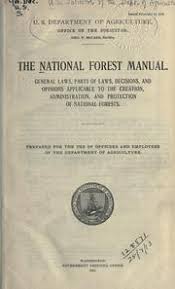
Here is a post from a short-lived blog I ran in 2005, Forest Planning Directives, about Forest Service planning Manual/Handbook rewriting. I think it may shed light on our planning rule critique as well. And it can serve as a guidepost, for the inevitable Manual/Handbook rewriting that will ensue just after the Draft Planning Rule moves to “Final.” Here it is, lightly edited:
Any role at all for NFMA Directives?
I have struggled for the last few days to better understand management and planning systems and ask myself whether we ought to keep any parts of the "interim directives." As usual I answer, No! You may find my thoughts amusing. You may find them bemusing. There is an odd chance you may find my thoughts enlightening. Here they are:
Land Management Planning as an Embedded Process
We have many processes (or systems) to help us manage the national forests and other public lands. Problem is these systems are often fractured and fragmented, and sometimes work at cross-purposes. We have tried to run our systems as pieces of a well-oiled machine. But it can’t work that way. The world is too complex for that, and sometimes politically wicked as well. A better management model is one that mimics nature, one comprised of self-organized complex adaptive systems. See Margaret Wheatley and Mryon Kellner-Rogers A Simpler Way for more.
Looking at things hierarchically, in a complex systems frame, we can see land management planning systems embedded in planning systems, embedded as part of "management systems."
Forest Service Management Systems
It proves helpful to see the map of interrelated systems that aid in adaptive management/organizational learning. Commonly recognized systems include:
- Assessment Systems
- Evaluation Systems
- Inventory Systems
- Monitoring Systems
- Planning Systems
Add to these supporting systems, like:
- Education and Training Systems
- Personnel Recruitment and Support Systems
- Budgeting and Finance Systems
- Information Technology Systems
- And so on
Now overlay all these with various "functions," like:
- Vegetation management (timber, range, etc.)
- Bio-physical resource management (soil and water, wildlife, plants, etc.)
- Fire management (suppression, pre-suppression, etc.)
- Facilities management systems
- Recreation management systems
- And so on
Finally overlay all with what we refer to as "Line Management," with about:
- 900 District Rangers, who report to
- 120 Forest Supervisors, who report to
- 9 Regional Foresters, who report to
- 1 Chief Forester
Now we can begin to get a glimpse of the complex nature of the management systems that we attempt organization with. The trick to all this is to make sure that the systems are not only complex, but adaptive and purposefully interrelated as well. No small order. And there are traps along the path we need to be aware of.
Decision Traps
Identifying systems and subsystems can either empower us or disable us. There are two traps that people commonly fall into here. First, we do not want to overly-reduce the complexity that enfolds us or we may develop overly complex systems or components in any one area, and at the same time neglect other important areas. This trap has been called "Abstracted Empiricism" or "Methodism."
Second, we may simply trap ourselves in the identification of the complex systems themselves. This trap is called "Grand Theory," where the trapped are paralyzed by their own overly-generalized identification and specification of complexity in the universe. In extreme form, this trap paralyzes people to the extent that they do not attempt any organization at all.
Interconnectivity, Dynamics, and Relationships
Traditionally we like to think of our organization as decentralized. But given law, policy, and Manual and Handbooks, etc. it is hardly decentralized.
We also traditionally think of our organization as working according to the dictates of "directives" that guide much of the action. Problem is, the directives tend not to be able to guide the workings of this (or any other) complex, adaptive, system. So what we have is a mess. We pretend to be decentralized, but that cannot be. We pretend to be directed in much of what we do, but the direction seems at best archaic, at worst unworkable from the get-go.
All the management systems are highly inter-connected. For now we will simply recognize them without pigeonholing them into some rigid structure like "plan-do-check- replan." This is not to say that we won’t keep that model in mind. Instead we don’t want to get trapped into thinking that is all we have to do. Our general approach should be mindful of our over-complexification dark side, our penchant to narrow our focus to the inner reaches of whatever box we find ourselves in and begin crafting ever-more- complex regulation, rules, technical guides, etc.
Take planning, for example. We have to plan before we develop any system or subsystem. But we can over-plan any system and ruin it. See, e.g. Henry Mintzberg, The Rise and Fall of Strategic Planning, 1994. In the Forest Service we have many over- planned and under-used systems. A lesson we continue to fail to learn, is that we need to design systems that can grow and develop as "users" continuously critique them and improve them. That means we have to start small, and let systems grow and develop as they are used. It also means that we have to weed out components, subsystems, and even whole systems that have outlived their usefulness. Pruning and tending are important, if unglamorous tasks in managing systems.
We need fewer teams of people to design work for other people, and more teams that design their own work and do it in ways that both improve and simplify the systems they work with. W. Edwards Deming champions such organization in his The New Economics: For Industry Government Education. Margaret Wheatley and Myron Kellner-Rogers lay out fundamental ideas and concepts on organization, information, and relationships in A Simpler Way. I recommend reading the books beginning with A Simpler Way, then moving to The New Economics, and finally for the devoted (and particularly for planning cheer-leaders) reading The Rise and Fall of Strategic Planning. But there is no way to practice adaptive management if we are unwilling to think about and read about ways to make it happen.
What does this mean for Manuals and Handbooks?
It means only that we had better do something very different from 18-30 feet of shelf space filled with cumbersome Manuals and Handbooks. We had better cut it all to the bare minimum. We had better take advantage of what’s out there in professional practice, and only add what must be added to help professionals work in our environment. It means The End of Bureaucracy & the Rise of the Intelligent Organization, which is also a very informative book written by Gifford and Elizabeth Pinchot. {Note Gifford is the grandson of the Forest Service’s founder.}
In this spirit, the Forest Service economists recently reduced about 100 pages of Manual and Handbook materials (FSM 1970, FSH 1909.17) to about 2 ¼ pages each for Manual and Handbook. The manual says, in essence, address social and economic context in various ways and places to help set a stage for managerial decision making. And highlight the social and economic consequence of proposed (and actual) action to the extent practical and foreseeable.
What does this mean for the Land Management Planning Manual & Handbook?
For Land Management Planning it means that we need to design and work with a subsystem that contributes to the whole rather than being parasitic on the whole. It means we need to quit thinking about controlling other systems. We need instead to think about contributing our small part to a broader whole.
First lets look at broad management systems. What might such a systems look like? What directives might guide it? The system is a complex web of multiply interrelated systems, all sharing some information with other systems while holding some information within any given system since it only adds "noise" to other systems. All systems are interrelated as well by the relationships between them, and by the relationships between those who take care of each system, and by the relationships of these people with those whose focus is broader, covering several or all systems.
Sustainability
The system is purpose driven, wandering down a path toward what many call sustainability. We know that the path is long, winding, and indeterminate. Sustainability is a vision quest. Sustainability is something that shape-shifts as we move down the path. But sustainability is also something that we are ever-mindful of. It is a goal that hovers in front of us, guiding us. Ecosystem constraints bound the path – some associated with natural and biological systems, some associated with human systems.
Long term, we are rewarded when we stay on the path toward sustainability, and punished when we stray beyond the bounds. Short term, we often blow the boundaries, sometimes by political design and sometimes by human error. Such deviations are punished, but the punishment may be felt by "contemporaneous others" or "future others." There are lags, often very long ones, in the feedback loops.
Surrounding our complex of managerial systems, and connected to them are broader-framed social systems with names like science, ethics, politics, beliefs, participation, that are part of the social/cultural environment. These systems interrelate with natural systems in the physical and biological realms.
Now let’s look at land management planning systems, embedded in ever-larger adaptive management frames.
Land Management Planning
What questions might guide our inquiry? (Similar questions might be framed for any planning)
- What is planning?
- How does it fit into adaptive management?
- What do we expect from planning?
- What if desired deliverables do not include a plan? Remember that Scenario Planning advocates and many others do not believe that the goal of planning be the production of a plan. Instead, they stress the importance of planning to rehash the past and rehearse the future.
- If we expect a plan, along with other deliverables, what do we want it to do?
- If we only want a plan to be a vision document, perchance highlighting vision over a variety of landscapes, but not making any how-to decisions, then we will answer this question much differently than if we expect a much more comprehensive, detailed plan.
Why bother with any Manual or Handbook? Why isn’t the NFMA Rule enough directive? Perchance the NFMA Rule is already too much directive, but that is a question for another time.
——————————–
2011 Update: Closely Related Posts
Why Three Planning Levels?
New Planning Rules Fails as Adaptive Management
The Frame Game





